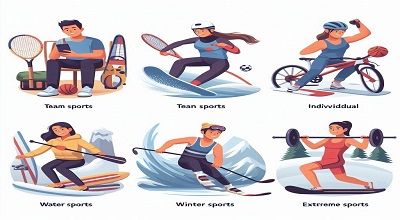5 categories of sports
There are the most popular 5 categories of sports. Sports can be categorized in various ways, and different classification systems may exist. However, a common way to categorize sports is based on their characteristics and shared attributes. Here are five general categories of sports:
Team Sports:
- Examples: soccer, basketball, football, hockey, and volleyball.
- Characteristics: Played between two teams, each typically consisting of multiple players. Team members collaborate to achieve a common goal, often scoring points or goals.
Individual Sports:
- Examples: tennis, golf, swimming, track, and field events.
- Characteristics: Competitors participate on their own, without teammates. Performance and outcome depend solely on an individual’s skills, abilities, and efforts.
Racket Sports:
- Examples: Tennis, badminton, squash.
- Characteristics: Involves the use of a racket (or similar equipment) to hit a ball or shuttlecock over a net. Players or teams compete to score points by successfully hitting the ball within the designated boundaries.
Combat Sports:
- Examples: Boxing, wrestling, judo, and karate.
- Characteristics: Involves physical contact between opponents to outscore or defeat the opponent. Various styles emphasize striking, grappling, or a combination of both.
Extreme Sports:
- Examples: skateboarding, snowboarding, rock climbing, BMX biking.
- Characteristics: Typically characterized by a high level of risk, adrenaline, and often unconventional environments. These sports often involve challenging natural elements and can be performed in extreme conditions.
Benefits of the above categories
Each category of sports offers a unique set of benefits, both physical and mental. Here are some general benefits associated with each category:
Team Sports:
- Social Interaction: Team sports foster social skills, communication, and camaraderie among teammates.
- Teamwork: Players learn to collaborate, trust each other, and work towards a common goal.
- Leadership: Team sports provide opportunities for individuals to develop leadership skills.
Individual Sports:
- Self-Reliance: Individual sports promote self-discipline, responsibility, and self-motivation.
- Personal Achievement: Success is often directly tied to personal effort, allowing individuals to experience a sense of accomplishment.
- Focus: Athletes in individual sports often develop strong concentration and focus abilities.
Racket Sports:
- Cardiovascular Fitness: Many racket sports require continuous movement, promoting cardiovascular health.
- Hand-Eye Coordination: These sports enhance hand-eye coordination and reflexes.
- Agility: Players develop agility and quick reaction times due to the fast-paced nature of many racket sports.
Combat Sports:
- Physical Fitness: Combat sports improve strength, endurance, flexibility, and overall physical conditioning.
- Self-Defense: Participants gain practical self-defense skills and heightened situational awareness.
- Discipline: Combat sports often instill discipline, respect for opponents, and adherence to rules.
Extreme Sports:
- Adrenaline Rush: These sports provide an exhilarating experience, leading to an adrenaline rush that can be both thrilling and stress-relieving.
- Risk Management: Participants learn to assess and manage risk, enhancing their decision-making skills.
- Mental Toughness: Extreme sports can contribute to mental resilience and the ability to face challenges head-on.
Final Summary
Keep in mind that these categories are not mutually exclusive, and some sports may fit into more than one category. Additionally, there are many other ways to classify sports based on factors such as the use of equipment, level of physical contact, or nature of the playing surface.
It’s important to note that individuals may choose sports based on personal preferences, and the benefits can vary from person to person. Additionally, many sports offer a combination of physical, mental, and social advantages, contributing to holistic well-being. Regular participation in sports can also have positive effects on overall health, including improved cardiovascular health, better mental health, and an enhanced mood.
